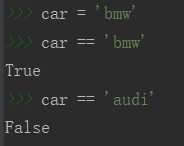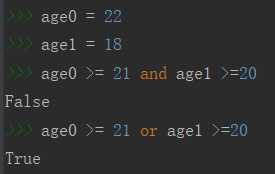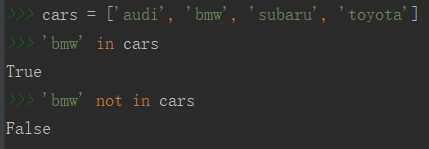Python中的if语句——参考Python编程从入门到实践
2020-12-13 02:40
标签:code image lower enter this text ima 相等 mamicode 一个等号表示赋值,两个等号用于判断等号左右两边是否相等,返回值为True或者False. 大小写不同的值视为不相等,例如继续写入代码:car == ‘Bmw‘,返回:False 此时就可引用lower()或者upper()函数进行字符串大小写的转换,方便比较。 与判断是否相等类似,不过是将第一个等号用感叹号替换,即:!= 表示不等运算符。 除了等于和不等之外,还可比较两者是否大于(>)、大于等于(>=)、小于(
可用关键字and或or将两个单独的条件判断合二为一: 给变量赋值为True或False,eg: edit = True 上述的代码中有3条打印语句,有点繁琐,也可简化为: 代码块中有多个if语句时,每个if语句都执行;但若是if-elif-else结构,代码运行时从前往后依次执行,一旦有条件满足,将不再执行后边的判断语句。 Python中的if语句——参考Python编程从入门到实践 标签:code image lower enter this text ima 相等 mamicode 原文地址:https://www.cnblogs.com/shirley-yang/p/11047885.html条件测试
1. 检查是否相等

2. 检查是否相等是需考虑大小写
3. 检查是否不相等
4. 其他条件判断
5. 判断多个条件

6. 检查特定值是否在列表中

7. 布尔表达式
if语句
1. 简单的if语句
# 判断是否达到投票的年龄
age = 19
if age >= 18:
print(‘You are old enough to vote!‘)2. if-else语句
age = 17
if age >= 18:
print(‘You are old enough to vote!‘)
else:
print(‘Sorry, you are too young to vote yet.‘)3. if-elif-else语句
age = 12
if age print(‘Your admission cost is 0 yuan.‘)
elif age print(‘Your admission cost is 5 yuan.‘)
else:
print(‘Your admission cost is 10 yuan.‘)if age price = 0
elif age price = 5
else:
price = 10
print(‘Your admission cost is ‘ + str(price) + ‘ yuan.‘) # 用str()将数字转换为字符型,否则会因类型不一致报错4. 使用多个elif代码块
if age price = 0
elif age price = 5
elif age price = 10
else:
price = 55. else代码块可以省略
用代码 elif age >= 65: 替换 else:
6. 多个条件
require_foods = [‘pizza‘, ‘falafel‘, ‘carrot cake‘]
if ‘pizza‘ in require_foods:
print(‘Adding pizza‘)
if ‘falafel‘ in require_foods:
print(‘Adding falafel‘)
elif ‘carrot cake‘ in require_foods:
print(‘Adding carrot cake‘)
print(‘This is you need.‘)
运行结果:
Adding pizza
Adding falafel
This is you need.if语句处理列表
1. 检查特殊元素
for require_food in require_foods:
if require_food == ‘carrot cake‘: # 判断需求是否存在
print(‘Sorry, we are out of carrot cake now.‘) # 打印供给不足
else:
print(‘Adding ‘ + require_food)
判断需求是否存在,存在则添加,不存在则抱歉。2. 确定列表是否为空
require_foods = []
if require_foods:
for require_food in require_foods:
print(‘Adding ‘ + require_food)
else:
print(‘Are you sure nothing you want?‘)
运行结果:
Are you sure nothing you want?
没有需求时确认一下。3. 使用多个列表
menu_lists = [‘pizza‘, ‘falafel‘, ‘carrot cake‘, ‘cannoli‘, ‘ice cream‘]
want_eats = [‘falafel‘, ‘carrot cake‘, ‘ice cream‘]
for want_eat in want_eats:
if want_eat in menu_lists:
print(‘Adding ‘ + want_eat)
else:
print(‘Sorry, we does not have ‘ + want_eat + ‘.‘)
点餐时添加菜单中有的,对于没有的表示抱歉。
上一篇:python之道09
下一篇:python常用模块(二)
文章标题:Python中的if语句——参考Python编程从入门到实践
文章链接:http://soscw.com/essay/26041.html